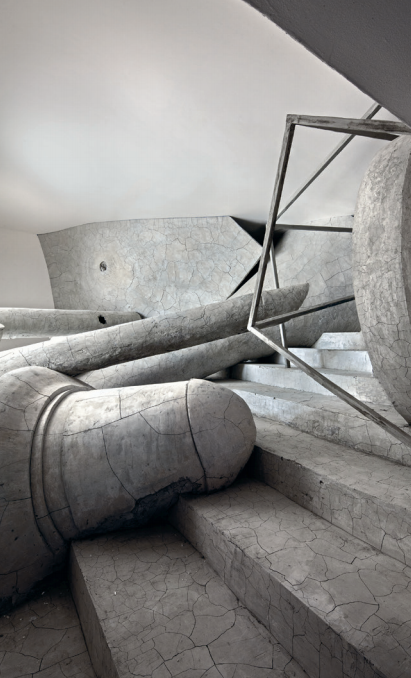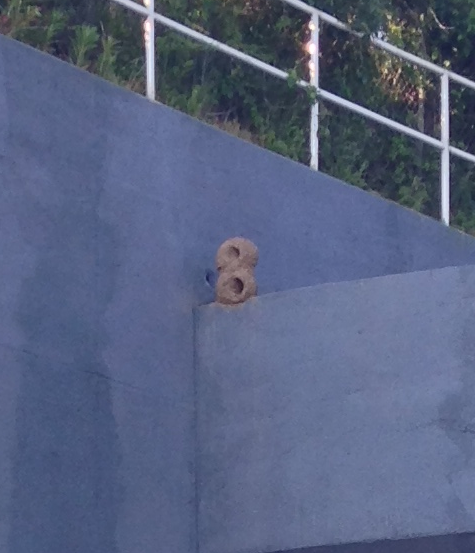“I celebrate myself, and sing myself….” I envisioned James Franco professing to the huddled masses, on the bus ride down to the Rockaways last Sunday. Franco had been slated to read Walt Whitman with Patti Smith that evening, to kick off the summer-long “Rockaway!” art festival: a tribute to the reopening of the old Sandy-damaged park, Fort Tilden. Conceived of by PS1 curator Klaus Biesenbach in collusion with Patti Smith, “Rockaway!” was co-organized by PS1, the Rockaway Artist Alliance (RAA), the Honolulu Biennial, and sponsored by the Jamaica Bay-Rockaway Parks Conservancy (JBRPC).
The idea of James Franco doing a rendition of “Song of Myself” (the Whitman poem which comes to mind) was funny, if a bizarre carrot for an event described as “an encouraging example of the many collaborations that have developed through the challenging process of rebuilding the Rockaways.” Strangely, these “collaborations” also translated into an offsite group show involving folks like Marina Abramovic, Olafur Eliasson, Elizabeth Peyton, and Laurie Simmons. What Marina Abramovic represents to the Rockaway community remains dubious. But Klaus Biesenbach had been instrumental in getting people down to the Rockaways for recovery efforts back in 2012, and this was a free art event off the Q35, so I went. And despite the big production, I recommend it. Here’s what I saw:
Janet Cardiff, “The Forty Part Motet” (2001)
It’s hard to describe just how moving Janet Cardiff’s reworking of a 16th century choral composition, Thomas Tallis’s “Spem in Alium,” is in this space. People walk in and hover around forty speakers, arranged in a semi-circle, each playing soft ambient murmuring. Suddenly, a steady female alto cuts through the room, joined by angelic sopranos and a swell of different male and female singers. Each speaker projects an individual voice, and you’re in the center of their collective rise and fall.
Every single person froze in their tracks and looked up; seconds later, tears welled, eyes closed and a few hugs were going around. It’s crazy how overpowering this is. But the best moment comes in the final measure, which seems to draw out a slightly different pitch in every voice. It sounds SO ARTY, but few people seemed to be immune to the emotional effect of the sound of forty individual voices, both distinct, and perfectly unified.
Cardiff’s speakers have recently travelled to PS1 and the Cloisters at the Met, but there’s something special about experiencing this in a room of anonymous beach goers in a recently restored but modest military chapel, precariously built on the edge of the ocean. As awkward as it is tearing up in a room full of art strangers, the piece practically beats an awareness of shared humanity into its viewers. The only comparable art experience I can think of is Nari Ward’s “Amazing Grace” at the New Museum last year.
Patti Smith, Photos and the “Resilience of the Dreamer”(2014)?
“It wasn’t ‘til Sandy that it became so popularized,” a woman commented in line for the Patti Smith installation “Resilience of the Dreamer” in a former locomotive repair factory. She was talking about the Rockaways, of course. The crowd was pretty art worldy.
Anyway, to get to the Patti Smith installation, you first pass through the RAA main gallery, a suite of Smith’s black-and-white silver gelatin prints from the past few decades– ghostly images of household objects which were precious to owners like Robert Mapplethorpe, Virginia Woolf, and Frida Kahlo. Others include tombs of figures like Walt Whitman and Baudelaire. The subject are benign, poetic, and banal—leaving you to wonder what all of this has to do with local hurricane recovery.
As it turns out, Patti Smith owns a bungalow in the area, which she’d purchased right before the storm hit, and she was moved by all of the thrownaway objects and beds in the neighborhood. So this series recalls that loss. It’s a stretch.
Smith’s “The Resilience of the Dreamer” in the backyard factory building, relates more clearly to the neighborhood. Thin white linens enshroud a gold four post bed, next to a dingy upturned upholstered graffitied armchair. This bed will remain in the factory until it degrades, and its opulent presence in the gutted factory makes you think of the temporality of the empire and the ephemerality of art and culture.
Still, it’s hard to compete with the beauty of “The Forty Part Motet.” There, people stopped and listened; immediately everybody pulled out their cellphones for snapshots here. In the next room, Smith offers a large bowl of white, water-smoothed stones which the audience is invited to take. We get poetic, but constructed, meaning; on such a large scale, the result is the “Mona Lisa Curse,” where audiences line up for their culture injection, and swiftly leave. It’s perhaps a fault of the work, but also an unfortunate side effect of art tourism.
Adrián Villar Rojas, “From the Series Brick Farm” (2013)
“Do you know how much longer ‘til we get to the sculptures?” a group of girls asked me on the long trail into the abandoned military batteries, hoping to find “sculptural objects” “inspired by nests” by Adrián Villar Rojas. They weren’t the only ones scratching their heads over their pamphlets, which showed images of the empty gun batteries next to images of Rojas’s monumental concrete sculptures. Apparently, the sculptures could be “found along the impressive hills and former batteries.”
By the time I passed the second of the two empty-looking batteries, and arrived at a similarly confused couple at the end of the trail, I was ready to cut my losses and just take in the rabbits and cardinals.
Finally I spotted the art: on top of the ledges are perched tiny nests that are almost invisible from the path. I wondered why would Rojas switch from monumental statement pieces to a hard-to-find, fragile habitat on the edge of a looming imperial structure. Ah. The Rockaways.
The conceit is a little annoying, given that few of my fellow visitors ever did seem to locate the work. But weighed against the high spectacle that’s now a basic ingredient of even the most high-minded art events, I was okay with just taking the walk.









Comments on this entry are closed.
{ 1 trackback }